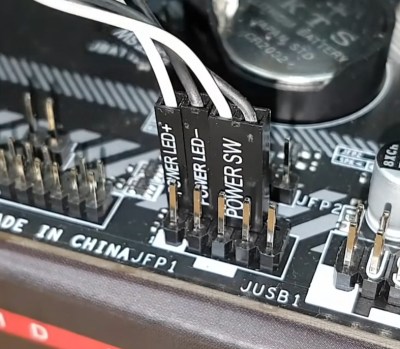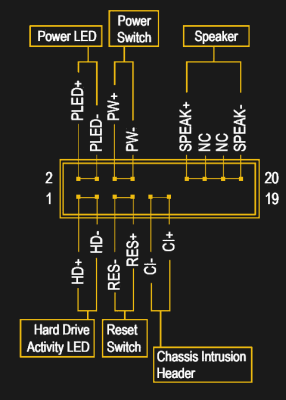In the dawning of the IBM PC era, the computer case was a heavy, stout thing. These were industrial machines, built with beefy paddle power switches, and weighing as much as a ton of bricks. Painted in only the ugliest beige, they set the tone for PC design for the next couple of decades.
At the turn of the millennium, the winds of change swept through. The Apple iMac redefined the computer as a hip, cool device, and other manufacturers began to reconsider their product aesthetics. Around the same time, the casemodding scene took off in earnest, with adherents building ever wilder battle stations for internet clout and glory.
With all the development that has gone in the last 40 years of the PC platform, we’ve seen great change and improvement in almost every area. But in building a new rig this past month, this writer discovered there’s one element of the modern PC that’s still trapped in the past.
Ugly Little Headers

It’s the cases, yes. Sure, the modern PC builder has a wider selection to choose from than ever. Whether your predilection is for built-in acrylic windows or dazzling fans festooned with RGB LEDs, you can have your fill in the modern market. Connectivity options are better than ever too, with front panels overflowing with USB ports, audio sockets and even fancy drive caddies if you so desire.
Despite this, the one thing that hasn’t changed is the ugly little headers used to connect the very basics of a computer case to the motherboard inside. Power and reset buttons, the internal case speaker, and status LEDs are all hooked up with fiddly little individual pin headers. With all the sophistication of a set of breadboard jumper wires, they’re a pain to install and an absolute joke on a platform that is otherwise at the cutting edge of computing technology.

What’s worse is that there is absolutely no reason it should be this way. As it stands, motherboard manufacturers are free to lay out their connections for these features any way they like, often simply lumping a double-row pin header on to the board and putting a pinout in the manual. However, some manufacturers have gone to a higher level, using a moulded and keyed connector on the board. Despite this, they’re still intended for use with the aforementioned individual pin connectors, just making them harder and more fiddly to install. What is maddening is that these often sit right next to other connectors on the motherboard, like front-panel USB-3 connectors, or HD audio headers. In both of these cases, motherboard manufacturers were able to agree a common standard such that a single connector carrying all necessary signals could be used to hook the case ports up to the motherboard. They still use cheap, 0.1″ pitch header-style connectors, but they bundle all the wires into one compact, keyed package, making install a one-step process.

Why this hasn’t been done yet for power buttons and status LEDs absolutely escapes me. Thus, I propose a solution. A simple keyed header-style connector that carries all the basics for a PC case, that can be implemented on all PC motherboards going forward, and of course, all PC cases. This covers the Power LED and button, the reset button, the hard drive activity LED, the speaker, and a chassis intrusion switch.
The proposed solution, the Day Case Connector, if you will, is based loosely off a design already used by some motherboard manufacturers. If I’m honest, the diagram is largely cribbed from an existing motherboard manual with some extraneous “features” removed, because we’re trying to get this shipped, after all. Audio and USB connections are best left to the already-existing front panel connectors which work fine, and would only complicate things here. This is simply a basic standard for the barebones components in a PC case. Obviously, some cases do not implement reset buttons or speakers, but this is not an issue — they can be left unpopulated without interfering with the proper operation of the connector. Alternatively, mandate that every case have these features, and rule with an iron fist.
Obviously, a scathing op-ed isn’t going to be enough to make this happen overnight. You’ll need to help, by petitioning your local Congressman, Senator, or Girl Scout Troop, to get behind the cause. Only the people can affect real change at the end of the day, after all. Some may deride us, pointing out that for the average user who builds one PC every few years, it shouldn’t be an issue. They may point out that the time spent writing this article is longer than it took to install the headers anyway. These are mere distractions, and they must not stray us from our goal.
So please, next time you build a PC, do not throw your hands up in despair. Instead, let yourself be moved to action. We shall right this wrong before the decade is out — you have my word. Godspeed!
No comments:
Post a Comment